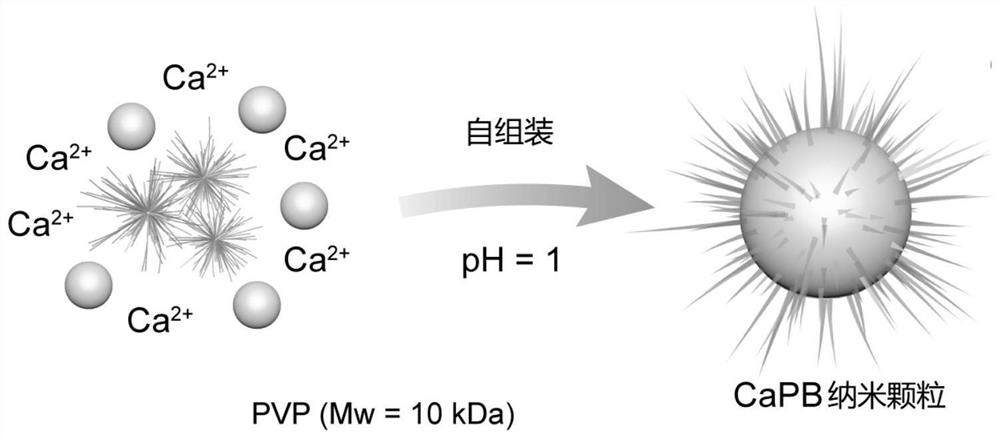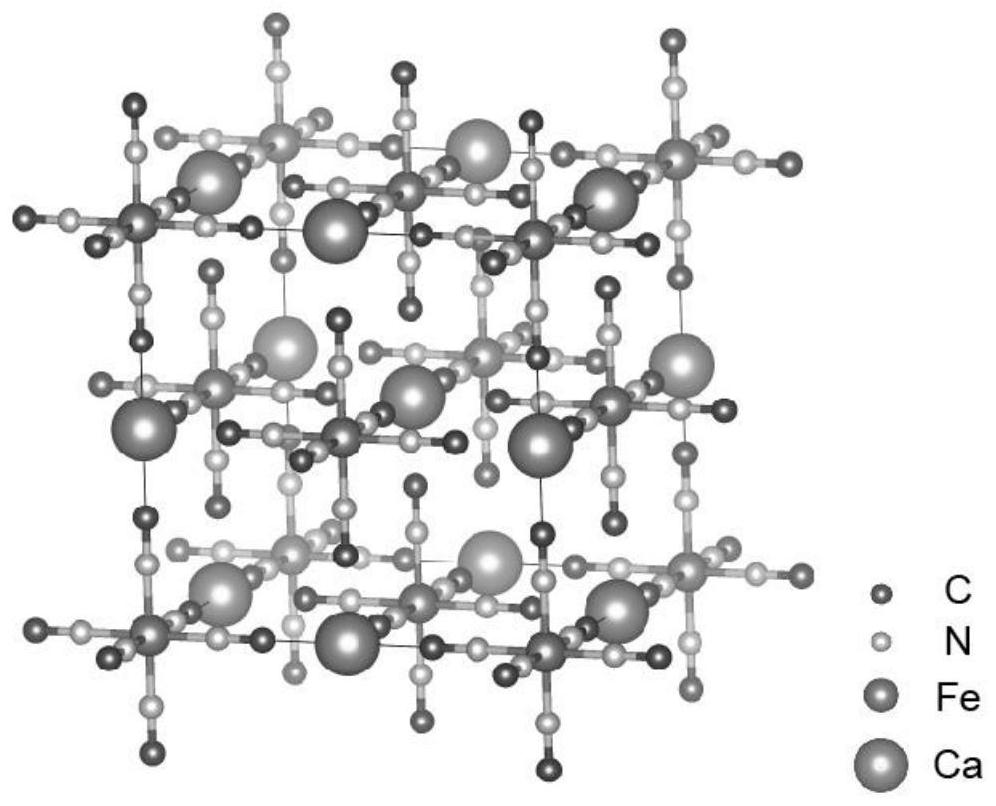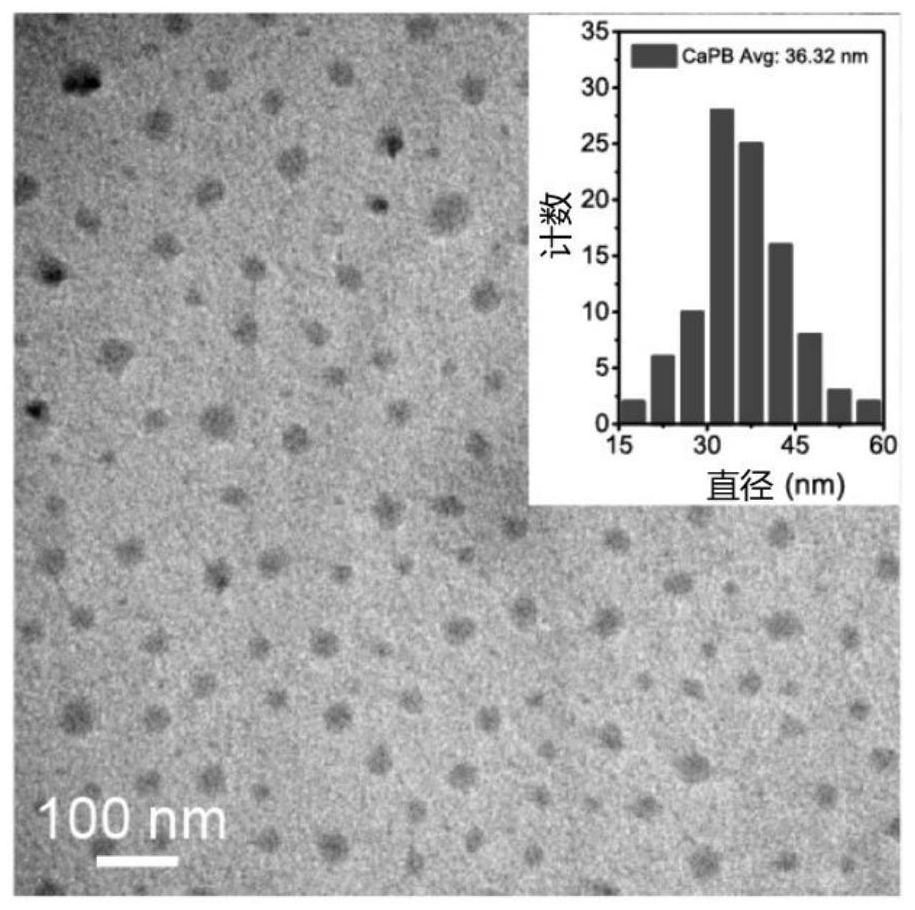Application of CaPB nanoparticles in preparation of drugs for treating retinal degenerative diseases
A technology for retinal degeneration and disease treatment, which can be used in drug combination, sensory disease, drug delivery, etc., can solve the problems of mitochondrial iron homeostasis destruction and limited effect, and achieve the effects of good biocompatibility, long-term efficacy and simple preparation.
- Summary
- Abstract
- Description
- Claims
- Application Information
AI Technical Summary
Problems solved by technology
Method used
Image
Examples
Embodiment 1
[0041] Preparation Example 1 CaPB embodiment nanoparticles
[0042] The 88.8mg of calcium chloride was dissolved in 10mL pH = 1 of deionized water to prepare a solution;
[0043] The 263.4mg potassium ferricyanide was dissolved in deionized water and 40mL pH = 1, 2 to obtain a solution;
[0044] The 300mg PVP (1w) was dissolved in deionized water and 30mL pH = 1, and 3 to obtain a solution;
[0045] The mixed solution 1 and 3, at a rate of 1 second is added dropwise a solution of 2, 1 hour of reaction, i.e. prepared CaPB nanoparticles having an average spherical particles (including PVP) diameter of about 36nm, such as image 3 Indicated.
[0046] The present invention is mediated by a simple polymer nucleation, calcium ions are uniformly doped Prussian Blue analogs constructed surface having a biocompatible polyvinyl pyrrolidone to form a modified nanoparticles.
Embodiment 2
[0047] Example 2 CaPB nanoparticles reduced ferrous ion levels in RPE in vitro
[0048] This embodiment employs vitro experiments, i.e. retinal pigment epithelial cell line (ARPE-19) as the research object, verified experimentally CaPB nanoparticles oxidative stress-inducing agent is sodium iodine (NaIO4 3 ) Protective effect induced retinal degeneration (typically cell model retinal degenerative diseases of dry AMD) is, we use the ferrous chelates desferrioxamine (the DFO) as a positive control.
[0049] By FerroOrange probe staining, we found NaIO 3 ARPE-19 cells (3OmM) in culture, significantly increased levels of ferrous ions, and CaPB (40ppm) and DFO (75μM) significantly decreased after treatment of NaIO 3 Levels induced by ferrous ions ( Figure 4 ), Suggesting CaPB significant iron binding capacity.
Embodiment 3
[0050] Example 3 CaPB nanoparticles protective retinal pigment epithelial cell degeneration
[0051] We further investigated whether nanoparticles CaPB similar therapeutic effects in vitro and in vivo. NaIO 3 The method of treatment of mice by tail vein injection of 35mg / kg of NaIO 3 A method for in vivo administration by intravitreal injection the mice at a concentration of 200ppm of 1μL CAPB, 1μL or DFO 100μM concentration; the time of administration is intravitreal injection CAPB DFO 15 minutes before or by NaIO 3 Tail vein injection. Sample detection was isolated from the mouse retina through the respective treatment RPE primary cells, abbreviated mRPE.
[0052] By mRPE elemental analysis, we found NaIO 3 Ferrous ion levels of treated group gradually increased over time ( Figure 5 Left), when treated with NaIO nanoparticles CaPB 3 Mouse retinas injected 2 weeks, 3 weeks and 4 weeks later, mRPE ferrous ion levels continued to decrease over time ( Figure 5 Right), indicating C...
PUM
| Property | Measurement | Unit |
|---|---|---|
| Diameter | aaaaa | aaaaa |
Abstract
Description
Claims
Application Information
 Login to View More
Login to View More - R&D
- Intellectual Property
- Life Sciences
- Materials
- Tech Scout
- Unparalleled Data Quality
- Higher Quality Content
- 60% Fewer Hallucinations
Browse by: Latest US Patents, China's latest patents, Technical Efficacy Thesaurus, Application Domain, Technology Topic, Popular Technical Reports.
© 2025 PatSnap. All rights reserved.Legal|Privacy policy|Modern Slavery Act Transparency Statement|Sitemap|About US| Contact US: help@patsnap.com



